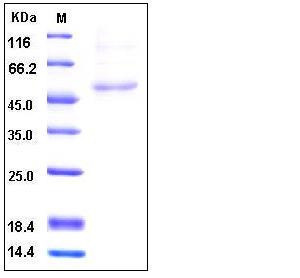Human HAPLN1 Protein (His Tag)
CRTL1
- 100ug (NPP3915) Please inquiry
| Catalog Number | P10323-H08H |
|---|---|
| Organism Species | Human |
| Host | Human Cells |
| Synonyms | CRTL1 |
| Molecular Weight | The mature recombinant human HAPLN1 consisting of 350 amino acids has a calculated molecular mass of 40 kDa. As a result of glycosylation, it migrates with a molecular mass of approximately 52 kDa in SDS-PAGE under reducing conditions. |
| predicted N | Asp 16 |
| SDS-PAGE |  |
| Purity | > 90 % as determined by SDS-PAGE |
| Protein Construction | A DNA sequence encoding the human HAPLN1 (NP_001875.1) (Met 1-Asn 354) was expressed with a C-terminal polyhistidine tag. |
| Bio-activity | |
| Research Area | Cancer |Invasion microenvironment |Adhesion molecule |Extracelluar matrix |Hyaluronan and HA-binding proteins |
| Formulation | Lyophilized from sterile PBS, pH 7.4 1. Normally 5 % - 8 % trehalose and mannitol are added as protectants before lyophilization. Specific concentrations are included in the hardcopy of COA. |
| Background | Hyaluronan (HA) is a high MW glycosaminoglycan significantly involved in the formation and stability of extracellular matrix via its association with specific HA-binding proteins. HAPLN1, also known as CRTL1 (Cartilage Link Protein 1, cLP ) and link protein, is a member of HA-binding protein (hyaladherins) family, and contains a common structural domain of about 100 amino acids that is termed a Link module with two α-helices and two antiparallel β-sheets. HAPLN1/CRTL1 stabilizes the interaction between hyaluronan (HA) and versican, two extracellular matrix components essential for cardiac development. Link module superfamily can be divided into three subgroups, and the HAPLN family are C domain-type proteins that have an extended structure with one N-terminal V-type Ig-like domain followed by two link modules. In cartilage, aggrecan forms - cLP stabilized aggregates with HA that provides the tissue with its load bearing properties. HAPLN1 is a component of follicular matrix, was shown to enhance cumulus-oocyte complex (COC) expansion in vitro. HAPLN1 may promote periovulatory granulosa cell survival, which would facilitate their differentiation into luteal cells. |
| Reference |
